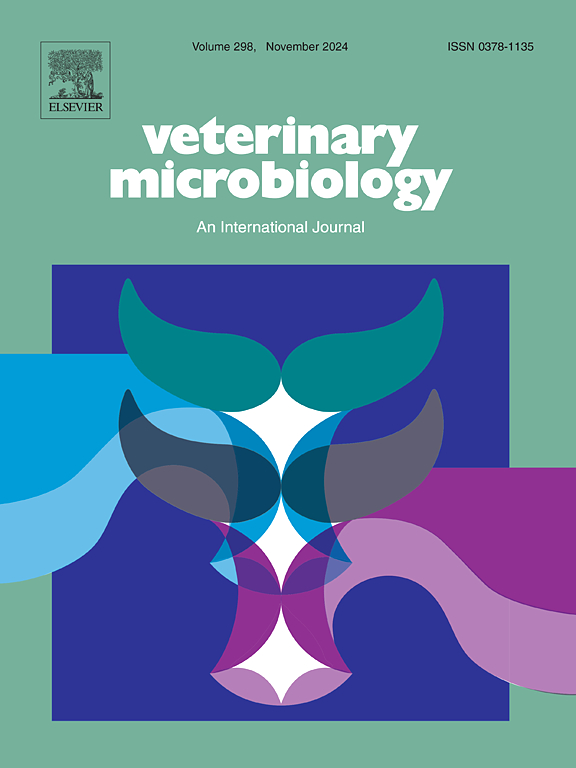鸭疫里默氏菌血清分型、分子分型和疫苗蛋白筛选:克服预防和治疗方面的挑战
IF 2.7
2区 农林科学
Q3 MICROBIOLOGY
引用次数: 0
摘要
鸭疫里默氏菌影响全世界的养鸭业,造成重大经济损失。目前的疾病预防和治疗战略主要包括疫苗和抗生素。然而,大量的血清型和对禽疫r虫日益增加的耐药性使得预防和治疗感染具有挑战性。本研究对51 R进行血清分型和分子分型。基于泛基因组分析和交叉免疫保护潜力的鸭疫病毒株和预测疫苗蛋白。血清型鉴定采用抗原免疫兔,制备9份血清分型血清,共6种血清型,其中2株未定型。自制血清型与外交菌株血清型结果一致。此外,还对51 R进行了泛基因组分析。构建了5094个基因的开放泛基因组。此外,COG注释分类表明,核心基因组和非核心基因组在基因功能上存在显著差异。共分析了1116个可作为交叉保护疫苗蛋白的核心基因组,发现了5个感兴趣的基因。此外,表达并纯化了高反应性蛋白oprM-1,并通过Western blotting验证了其与5种抗血清(抗血清型1、2、5、11、18)的免疫反应性。本研究将血清分型、MLST分型和泛基因组分析相结合,填补了现有禽疫鼠分型系统的空白。此外,它为禽疫r的流行病学、进化和发病机制提供了有价值的见解,并为开发有效的交叉保护疫苗铺平了道路。本文章由计算机程序翻译,如有差异,请以英文原文为准。
Serotyping, molecular typing, and vaccine protein screening for Riemerella anatipestifer: Overcoming challenges in prevention and treatment
Riemerella anatipestifer (R. anatipestifer) affects the duck farming industry worldwide, causing substantial economic losses. The current disease prevention and treatment strategies primarily include vaccines and antibiotics. However, the large number of serotypes and increasing resistance to R. anatipestifer make it challenging to prevent and treat the infection. This study carried out the serotyping and molecular typing of 51 R. anatipestifer strains and predicted vaccine proteins based on pan-genome analysis and cross-immune protection potential. For serotype identification, the rabbits were immunized with antigens, and 9 serotyped sera were prepared, the data revealed 6 serotypes with two unformed strains. The results for the self-made serotypes were consistent with those obtained from the externally submitted strains. Moreover, the pan-genome analysis was performed on 51 R. anatipestifer strains, and an open pan-genome set of 5094 genes was constructed. In addition, the COG annotation classification indicated that the core and non-core genomes were significantly different in gene functions. A total of 1116 core genomes that could serve as better cross-protective vaccine proteins were analyzed and revealed 5 genes of interest. In addition, the oprM-1 protein, a highly reactive protein, was expressed and purified, and the immunoreactivity with five antisera (anti-serotypes 1, 2, 5, 11, and 18) was demonstrated by Western blotting. This study fills the gaps in the existing typing systems for R. anatipestifer by combining serotyping, MLST typing, and pan-genome analysis. Furthermore, it provides valuable insights into the epidemiology, evolution, and pathogenesis of R. anatipestifer and paves the way for developing effective cross-protective vaccines.
求助全文
通过发布文献求助,成功后即可免费获取论文全文。
去求助
来源期刊

Veterinary microbiology
农林科学-兽医学
CiteScore
5.90
自引率
6.10%
发文量
221
审稿时长
52 days
期刊介绍:
Veterinary Microbiology is concerned with microbial (bacterial, fungal, viral) diseases of domesticated vertebrate animals (livestock, companion animals, fur-bearing animals, game, poultry, fish) that supply food, other useful products or companionship. In addition, Microbial diseases of wild animals living in captivity, or as members of the feral fauna will also be considered if the infections are of interest because of their interrelation with humans (zoonoses) and/or domestic animals. Studies of antimicrobial resistance are also included, provided that the results represent a substantial advance in knowledge. Authors are strongly encouraged to read - prior to submission - the Editorials (''Scope or cope'' and ''Scope or cope II'') published previously in the journal. The Editors reserve the right to suggest submission to another journal for those papers which they feel would be more appropriate for consideration by that journal.
Original research papers of high quality and novelty on aspects of control, host response, molecular biology, pathogenesis, prevention, and treatment of microbial diseases of animals are published. Papers dealing primarily with immunology, epidemiology, molecular biology and antiviral or microbial agents will only be considered if they demonstrate a clear impact on a disease. Papers focusing solely on diagnostic techniques (such as another PCR protocol or ELISA) will not be published - focus should be on a microorganism and not on a particular technique. Papers only reporting microbial sequences, transcriptomics data, or proteomics data will not be considered unless the results represent a substantial advance in knowledge.
Drug trial papers will be considered if they have general application or significance. Papers on the identification of microorganisms will also be considered, but detailed taxonomic studies do not fall within the scope of the journal. Case reports will not be published, unless they have general application or contain novel aspects. Papers of geographically limited interest, which repeat what had been established elsewhere will not be considered. The readership of the journal is global.
 求助内容:
求助内容: 应助结果提醒方式:
应助结果提醒方式:


